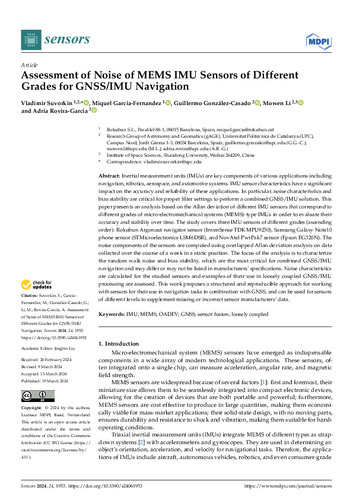Articles de revista
Enviaments recents
-
Assessment of noise of MEMS IMU sensors of different grades for GNSS/IMU navigation

(Multidisciplinary Digital Publishing Institute (MDPI), 2024-03-19)
(Multidisciplinary Digital Publishing Institute (MDPI), 2024-03-19)
Article
Accés obertInertial measurement units (IMUs) are key components of various applications including navigation, robotics, aerospace, and automotive systems. IMU sensor characteristics have a significant impact on the accuracy and ... -
The 2021 la Palma volcanic eruption and its impact on ionospheric scintillation as measured from GNSS reference stations, GNSS-R and GNSS-RO

(European Geosciences Union (EGU), 2023-11-29)
(European Geosciences Union (EGU), 2023-11-29)
Article
Accés obertIonospheric disturbances induced by seismic activity have been studied in recent years by many authors, showing an impact both before and after the occurrence of earthquakes. In this study, the ionospheric scintillation ... -
The selection of basic functions for a time-varying model of unmodeled errors in medium and long GNSS baselines

(Multidisciplinary Digital Publishing Institute (MDPI), 2023-10-19)
(Multidisciplinary Digital Publishing Institute (MDPI), 2023-10-19)
Article
Accés obertUnmodeled errors play a critical role in improving the positioning accuracy of Global Navigation Satellite Systems. Few studies have addressed unmodeled errors in medium and long baselines using their time correlation, ... -
Inter-system biases solution strategies in multi-GNSS kinematic precise point positioning

(2023-07)
(2023-07)
Article
Accés obertEstimating inter-system biases (ISBs) is important in multi-constellation Global Navigation Satellite System (GNSS) processing. The present study aims to evaluate and screen out an optimal estimation strategy of ISB for ... -
Neural network based model for global Total Electron Content forecasting

(EDP Sciences, 2020-03)
(EDP Sciences, 2020-03)
Article
Accés obertWe introduce a novel empirical model to forecast, 24 h in advance, the Total Electron Content (TEC) at global scale. The technique leverages on the Global Ionospheric Map (GIM), provided by the International GNSS Service ... -
Comparison of GPS analysis strategies for high-accuracy vertical land motion

(2008-01)
(2008-01)
Article
Accés obertTide gauges measure sea level changes relative to land. To separate absolute changes in sea level from vertical land movements tide gauges are often co-located with Continuous GPS (CGPS). In order to achieve an accuracy ... -
The ionosphere prediction service prototype for GNSS users

(EDP Sciences, 2019)
(EDP Sciences, 2019)
Article
Accés obertThe effect of the Earth’s ionosphere represents the single largest contribution to the Global Navigation Satellite System (GNSS) error budget and abnormal ionospheric conditions can impose serious degradation on GNSS system ... -
WIDE AREA Real Time Kinematics (WARTK): nuevas posibilidades de posicionamiento y navegación GNSS precisa a escala continental

(2008-05-05)
(2008-05-05)
Article
Accés obertEn este artículo se presenta la nueva técnica Wide Area Real Time Kinematics (WARTK) que permite la extensión de técnicas previas de navegación precisa por satélite, como por ejemplo el Real Time Kinematics (RTK), más allá ... -
Enhanced neural network model for regional ionospheric modeling and evaluation under different solar-geomagnetic conditions

(2023-03-01)
(2023-03-01)
Article
Accés obertMonitoring spatiotemporal variations of ionospheric vertical total electron content (VTEC) is crucial for space weather and satellite positioning. In the present study, an enhanced neural network (ENN) model is proposed ... -
A Method to determine secondary codes and carrier phases of short snapshot signals

(2022-12)
(2022-12)
Article
Accés obertRecently, the Snapshot Real-Time Kinematic (SRTK) technique was demonstrated, which aims at achieving high accuracy navigation solutions with a very short signal collection. The main challenge in implementing SRTK is the ... -
On the global kinematic positioning variations during the September 2017 solar flare events

(John Wiley & sons, 2022-08)
(John Wiley & sons, 2022-08)
Article
Accés obertSeveral X-class solar flares (SFs) with different intensities and locations on the solar disk occurred in September 2017. Among them, the X9.3 SF on 6 September 2017 was the most intensive SF in the 24th solar cycle. In ... -
Applying the geodetic detrending technique for investigating the consistency of GPS L2P(Y) in several receivers

(2022-11)
(2022-11)
Article
Accés obertGlobal Navigation Satellite System signals have been used for years to study high-frequency fluctuations (f>0.1Hz)intheionosphere. The customary procedure uses the geometry-free (GF) combination ofL1andL2carriers, for which ...













